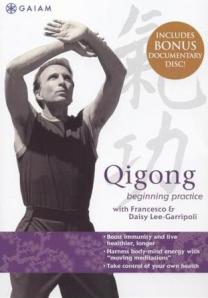Chi Off on the Wrong Foot
This week’s DVD is Qigong for Beginners, a two-disc set offering an approximately 70-minute workout and 55-minute documentary on qigong. The documentary was created by Garri Garripoli, and the workout is led by Garripoli with his wife Daisy Lee-Garripoli.
Qigong is pronounced “chee gung” – the pronunciation is the main thing I picked up from the accompanying one-hour documentary.
The documentary was a little disappointing. There was a little bit of good stuff about the history of qigong, but most of it was profiles of chi healing practitioners, where the qigong exercises were only a small part of the healing process. Chi healing seems to involve a lot of acupuncture, what looks like reiki, and also repeatedly poking the patient in the small of the back with a stick.
I wanted the documentary to show more details on the different qigong exercises and what they were used for. I also wanted more info on how (from a scientific perspective) the exercises worked. I didn’t come away with any of that background on the exercises, and I felt like the info on qigong healing wasn’t something I could really apply in my own life.
In the 70-minute workout, the exercises themselves were interesting. I recognized a lot of elements of tai chi (and according to the documentary qigong is the foundation of tai chi … so I guess I learned two things from watching the documentary).
Like many other tai chi videos I’ve done, the moves are not mirrored. Perhaps this is because if the instructor starts off on the wrong foot, his chi will become misaligned? This is something else I would have been interested to learn about in the documentary.
At any rate, the moves are not mirrored, so you have to listen closely to what the instructor is saying to do, rather than just watching the movements. This whole plan falls apart after the first couple of repetitions of each move, when Garripoli switches to just telling you when to inhale and exhale, without talking you through the movements you should be doing.
There are a few saving graces here. First, like tai chi, it moves pretty slowly, so you have plenty of time to correct once you realize you’re doing it wrong.
Second, once Garripoli shows you a move or a sequence of a couple of moves, you do that move for 3-5 minutes. That’s right, minutes. So, you have plenty of time to get the hang of it before you move on to something else.
I actually really liked the approach of doing a move for several minutes – it allowed you to really get into the meditative aspect of what you were doing. My chi was probably flowing like gangbusters.
The first 19 minutes of the workout cover the fundamentals of qigong, following the same pattern of learning a move and repeating it for several minutes.
After the fundamentals, Garripoli introduces the next 40-minute segment, which covers the 18 traditional qigong exercises (forms). The sunrise move should be done first and the sunset move last. In between these two moves, he recommends doing the other 16 moves in random order, to represent the chaos of the universe. He does not provide any suggestions about how to play those moves in random order – the DVD certainly doesn’t have an option for it.
During each move, Garripoli summarizes the health benefits of doing that move. This is the kind of information I expected to see in the documentary, but I’ll take it where I can get it. However, it is more difficult to pay attention to the benefits info while you’re trying to focus on doing the mirrored moves correctly.
There is a lot of emphasis on neck and shoulder work. Many of the exercises are essentially range-of-motion exercises, so I can see where China would be touting this as medicinal. Sort of the Eastern equivalent of physical therapy.
After the 18 forms segment, the workout wraps up with about 11 minutes of self-massage – a unique cooldown, for sure. The section moves pretty quickly, and covers massage of the face, scalp, ears, eyes, sinuses, jaw, throat, legs, lumbar/kidney, and finally a few all-over moves to release tension (and stagnant chi!) throughout the body.
It really felt like three workouts (fundamentals, 18 forms, and massage) strung end to end. Not only was there no chaptering in the 18 forms (so you could attempt to do them in some kind of random order as suggested), there wasn’t even any chaptering for the three main parts of the workout. I would have liked more menu options to pick and choose parts of the long workout to do.
The final verdict? This DVD really piqued my interest in qigong, but I think I’ll be looking for a different qigong DVD – one that better fits my uncoordinated workout style.
